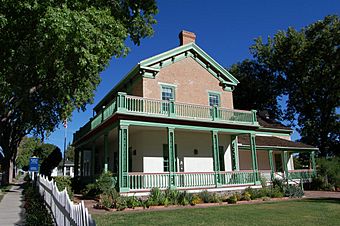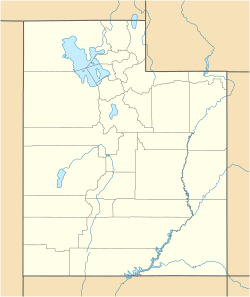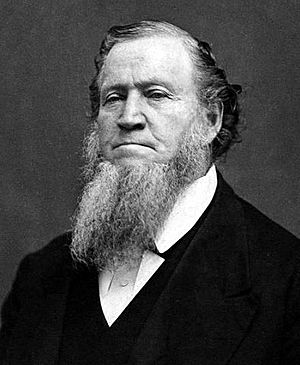Brigham Young Winter Home and Office facts for kids
Quick facts for kids |
|
|
Brigham Young Winter Home and Office
|
|
 |
|
| Location | Southeast corner of 200 North and 100 West St. George, Utah United States |
|---|---|
| Built | circa 1869 to 1873 |
| Architect | Miles Romney and Miles Park Romney |
| Restored | 1962 to 1963, 1975 to 1976, 2002 to 2003 |
| Restored by | State of Utah, The Church of Jesus Christ of Latter-day Saints |
| NRHP reference No. | 71000863 |
| Added to NRHP | February 22, 1971 |
The Brigham Young Winter Home and Office is a historic house museum in St. George, Utah. This home and office once belonged to Brigham Young. He was an important Mormon pioneer and the second president of The Church of Jesus Christ of Latter-day Saints.
As Brigham Young got older, he had arthritis. This made it hard for him to spend winters in the cold Salt Lake City area. So, he got a winter home in St. George. St. George is in the warm, dry Dixie region of Utah. He lived there during the winters from 1873 to 1877.
After Young passed away, the home stayed a private house. Later, St. George's first dentist, Jedediah M. Gates, bought it. The Young Family Association bought the house in 1955. Four years later, the state of Utah owned it. The state fixed up the home and opened it to the public in 1963. In 1974, The Church of Jesus Christ of Latter-day Saints bought the property from the state. Since then, the church has run the house museum. Church volunteers give free tours there.
Contents
History of the Winter Home
Who Was Brigham Young?
Brigham Young was a skilled worker from Vermont. He joined The Church of Jesus Christ of Latter-day Saints in 1830. Joseph Smith, who started the church, made Young an important leader. In 1844, Joseph Smith was killed. After this, there was a question about who should lead the church.
In early 1846, many church members who followed Young left their homes in Nauvoo, Illinois. They traveled west on the Mormon Trail to find a new place to live. They wanted to be away from people who were treating them badly. Young and his group arrived in the Salt Lake Valley in July 1847. There, they started Salt Lake City.
In the years that followed, Young asked groups of church members to start new towns. These towns were in Utah and nearby areas. They also worked to build roads and other important things. St. George was one of these towns. It was meant to be a place to grow cotton. The area was known for its warm weather, even in winter.
The House's Design and Building
As Brigham Young got older, he found that warm weather helped his arthritis. In the early 1870s, he bought a home in St. George. The Chesney family had recently built it. After Young bought it, a large two-story part was added. This made the house more than twice as big. An office building was also built next to it.
Miles Romney designed the original home. His son, Miles Park Romney, designed the new addition. The house has two stories and is made of light brown adobe bricks. The basement is made of red sandstone and has two rooms. The roof has wood shingles. Inside, the house has four fireplaces. Three are made of red sandstone, and one is made of adobe.
Inside the home, the church has some of Young's original furniture. Some of it he built himself. Other old pieces of furniture have been added too. The wood for the house came from the Mount Trumbull Wilderness and the Pine Valley Mountain Wilderness. The office is to the east of the house. It has stucco walls and a sandstone chimney.
Young first moved into the home in December 1873. His being there encouraged the local people to finish the St. George Utah Temple. The temple was officially opened in 1877.
The home was first recognized with a historic marker in 1947. The Daughters of Utah Pioneers put it there. It was also added to the National Register of Historic Places in 1971. This is a list of important historic places in the United States.
What Happened After Young Died?
Brigham Young passed away on August 29, 1877. His family later sold the home to Jedediah M. Gates. He was St. George's first dentist. After Gates died in 1947, his children put the property up for sale.
The Brigham Young Family Association decided to buy the home in 1955. Gordon Claridge Young, a great-grandson of Brigham Young, led this effort. The family group and the Sons of Utah Pioneers planned to fix up the home and open it for tours. But it was too expensive for the family to do this.
In 1959, the state of Utah bought the family's share in the home. They also paid off what was still owed to the Gates family. This gave the state full ownership. The state started fixing up the home in 1962. They moved the front door and a stairway back to where they originally were. George Cannon Young, another grandson of Brigham Young, was the architect who watched over this work.
The fixed-up home and office were officially opened on June 14, 1963. It became part of Dixie State Park. This park is now called Snow Canyon State Park. Important people like State Senator Orval Hafen and church leaders Hugh B. Brown and Marion G. Romney were at the opening.
In 1974, The Church of Jesus Christ of Latter-day Saints and the Utah state government made a deal. The state would give Young's Winter Home and Office (and the nearby Jacob Hamblin House) to the church. In return, the church would give the state the historic Brigham Young Forest Farmhouse in Salt Lake City. The church would then run the two homes in southern Utah as visitor centers. The state would move the Forest Farmhouse to Pioneer Trail State Park. This park is now called This Is the Place Heritage Park. There, it would be a part of Old Deseret Village.
Young's Winter Home and Office first opened under church control in April 1975. But it closed that August for more repairs and fixing up. After being refurbished, both Young's home and Hamblin's home were officially opened by church leader L. Tom Perry on May 29, 1976.
On May 31, 2003, the home reopened after a project that lasted several months. This project made the building stronger. It helped the walls and roof be better able to survive earthquakes. The outside wood of the home was also painted moss green. This was its original color. Many old buildings in St. George were painted this shade of green. This happened because the wrong paint color was sent for the St. George Temple. The early settlers just used the paint they had.
See also
- Brigham Young Complex:
- Beehive House
- Lion House
- Gardo House
- National Register of Historic Places in Washington County, Utah




